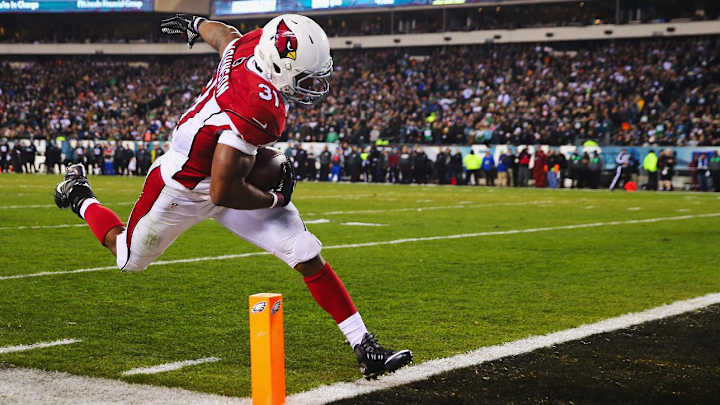Arizona Cardinals: 10 Things You Need to Know

1. We can talk Carson Palmer all we want, but if Arizona’s offensive line doesn’t play markedly better, this team has no chance. Bruce Arians’s system demands a lot of the O-line. It features five-step dropbacks and often has all five eligible receivers out in routes, leaving the front five with no help-blockers. Last year the Cardinals allowed 127 QB hits, third most in the league.
2. Here are the concerns with that O-line, listed in order of significance: A) Left tackle D.J. Humphries. He struggled mightily at right tackle last season. B) The right guard position. Last year’s fourth-round pick, Evan Boehm, and this year’s fourth-rounder, Dorian Johnson, will compete for it. With inexperience at that spot, defenses will continue to attack the Cardinals with stunts and slants inside. C) Left guard Mike Iupati. By his own standards, he was awful in 2016, both in awareness and execution. D) Right tackle Jared Veldheer. Not only is he switching sides (which isn’t easy), he’s also returning from a torn triceps.
James Harrison: Fake News, and Real Thoughts About Anthem Protests
3. Carson Palmer must read the field with the clarity that he did in 2015. For whatever reason (OL struggles? Nagging injuries? Diminishing skills?) Palmer was not as sharp mentally last year. Arizona employs a well-crafted, timing-and-precision aerial assault. It’s imperative the quarterback be on-point, especially when throwing to targets in the 15- to 20-yard levels.
4. Given that David Johnson might be the best receiving back in football (and all-around running back period), the Cardinals can really threaten defenses when they go to a 4-receiver, 1-back set, which they used more than all but two teams last season. In that formation, you’d get Johnson dictating matchups out wide or in the slot, you have stud possession target Larry Fitzgerald as a security blanket inside, and you threaten with three sheer speedsters in Jaron Brown, a now-healthy John Brown and J.J. Nelson. Few defenses have an answer for five big-time receiving weapons like that.
The Women Who Are Changing the Face of the NFL
5. Who would have ever believed that Fitzgerald would cement his Hall of Fame credentials by becoming football’s best blocking receiver late in his career? Arizona’s top running play involves Fitzgerald motioning down behind two line-of-scrimmage tight ends and blocking a second-level defender at the point of attack. It’s all part of an offensive system that features a lot of condensed formations, with receivers and tight ends grouped tightly together, toward the middle of the field.
6. No one noticed because the Cardinals weren’t winning, but this defense ranked third in yards allowed per pass attempt and rush attempt in 2016. It also recorded a league-high 48 sacks. It’ll be difficult to maintain this level in 2017. Half the starters are gone, including emerging star safety Tony Jefferson (Ravens) and domineering defensive lineman Calais Campbell (Jaguars). The Cardinals brought in a mix of veteran experience (LB Karlos Dansby, S Antoine Bethea) and young talent (LB Haason Reddick, S Budda Baker), but incorporating everyone into coordinator James Bettcher’s multifarious, complex scheme could be challenging early on.
7. Arizona has the NFL’s best pure cover corner in Patrick Peterson, but the spot opposite him is once again in question. Marcus Cooper, who filled it aptly last year, was part of the mass exodus in the spring. And so it’s on either undeveloped youngster Brandon Williams or never-developed sixth-year pro Justin Bethel again. The Cardinals play a ton of matchup coverages out of single-high safety looks. A glaring weakness at corner is problematic.
8. Two men will be counted on to replace the perhaps irreplaceable Calais Campbell: last year’s first-round pick Robert Nkemdiche and third-year pro Rodney Gunter. Both have a chance. Nkemdiche is talented and, after a jarring first-year adjustment period to NFL life, he’s in much better standing with his coaches. Gunter really came on toward the end of last season, flashing both power and penetration capabilities.
The Dolphins Are Getting to Know Jay Cutler, Man Behind the Memes
9. It’s a big year for Tyrann Mathieu. If he stays healthy, he’ll remain in the five-year, $62.5 million contract he signed last August. If he doesn’t, the Cardinals can wiggle out of it. The second-round selection of Budda Baker, who is similar to Mathieu in size and style, gives the Cardinals options for how to deploy their interior defensive backs. Those decisions should start with wherever Mathieu is most destructive. Slot? Strong safety? Free safety?
10. In crucial late-game moments, Bettcher has a distinct tendency to blitz über-aggressively. In fact, the offense is liable to see a Cover 0 pressure, where the defense rushes everyone who doesn’t have a specific eligible receiver to guard. Bettcher gets this mentality from Arians, who prefers to attack rather than react.
Question? Comment? Story idea? Let us know at talkback@themmqb.com
